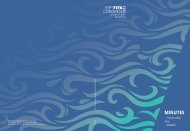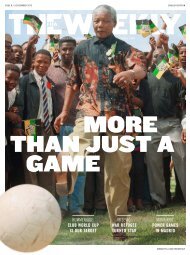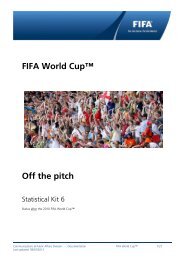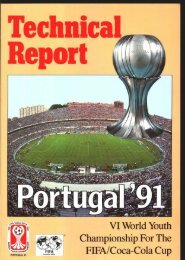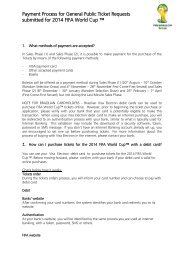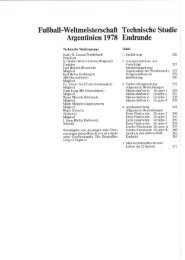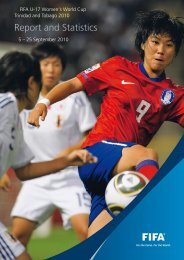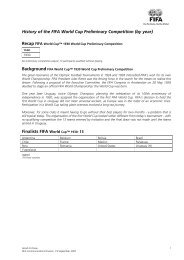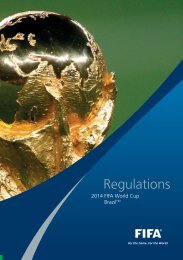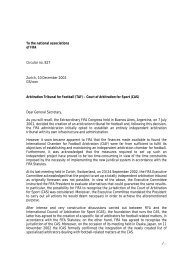Nutrition for football - FIFA.com
Nutrition for football - FIFA.com
Nutrition for football - FIFA.com
Create successful ePaper yourself
Turn your PDF publications into a flip-book with our unique Google optimized e-Paper software.
26 NUTRITION FOR FOOTBALL | hydratioN StratEGiES<br />
NUTRITION FOR FOOTBALL | hydratioN StratEGiES 27<br />
Hydration<br />
strategies<br />
When players work hard, they lose sweat – in a game on<br />
a hot day, sweat losses may reach 3 litres. On a cold day,<br />
though, some players will lose very little sweat. Every<br />
player’s hydration needs are different and will vary with<br />
the weather over the season. Just as general training and<br />
<strong>com</strong>petition strategies should be tailored <strong>for</strong> individual<br />
athletes in accordance with their unique needs and<br />
preferences, so should their drinking and eating choices<br />
during exercise. Players, coaches, and trainers should<br />
‚fine tune‘ these re<strong>com</strong>mendations to identify their own<br />
winning <strong>for</strong>mula.<br />
how much and when to drink?<br />
Players should limit dehydration during training and<br />
matches by drinking water or a sports drink. Obvious<br />
opportunities to drink during a match include warm-up<br />
and at half time. During training, the coach or manager<br />
should organise drink breaks according to the weather<br />
and intensity of the session.<br />
Training allows opportunities <strong>for</strong> players to get a<br />
feel <strong>for</strong> sweat rates and fluid needs so that drink practices<br />
can be adjusted accordingly (see box). It is not necessary<br />
to drink enough to match sweat loss, but the amount of<br />
dehydration should normally be limited to a loss of less<br />
than about 2% of body weight (ie, 1.0 kg <strong>for</strong> 50 kg<br />
person, 1.5 kg <strong>for</strong> a 75 kg person, and 2 kg <strong>for</strong> a 100 kg<br />
person).<br />
The negative effects of dehydration on highintensity<br />
per<strong>for</strong>mance are greater in warm environments,<br />
so drinking practices in these conditions should be<br />
upgraded to reduce the overall fluid deficit. This may<br />
include drinking at the side-line when match play is<br />
interrupted, or having extra drink breaks during training<br />
sessions.<br />
There should never be a need to drink more than<br />
the sweat loss so that weight is gained during exercise.<br />
This will not help per<strong>for</strong>mance and is likely to cause gut<br />
dis<strong>com</strong><strong>for</strong>t.<br />
When do you need more than water?<br />
Depletion of fuel stores can be an issue <strong>for</strong> <strong>football</strong><br />
matches, especially <strong>for</strong> players in mobile positions or<br />
with a running game style. High carbohydrate strategies<br />
– fuelling up <strong>for</strong> the game and consuming extra<br />
carbohydrate during the match – have been shown to<br />
enhance per<strong>for</strong>mance in such players.<br />
Players should limit dehydration<br />
during training and matches by<br />
drinking water or a sports drink.<br />
Better intake of fluid and fuel during a game may not<br />
only keep players running further and faster in the<br />
second half of a match, but it can also help to maintain<br />
skills and judgement when players would otherwise<br />
be<strong>com</strong>e fatigued. Games are often won and lost in the<br />
last minutes of the match, and fatigued players are at<br />
increased risk of injury.<br />
The use of <strong>com</strong>mercial sports drinks with a<br />
carbohydrate content of about 4-8% (4-8 g/100 ml)<br />
allows carbohydrate and fluid needs to be met<br />
simultaneously in most events. The intake of carbohydrate<br />
that is generally associated with per<strong>for</strong>mance benefits is<br />
~ 20-60 g per hour.<br />
Sodium should be included in fluids consumed during<br />
exercise lasting longer than 1-2 hours or by individuals<br />
during any event that stimulates high salt losses.. You<br />
can recognise “salty sweaters” by the salt rings on their<br />
clothes at the end of a hard session on a hot day. Players<br />
who lose a lot of salt may be more prone to muscle<br />
cramps. Adding a little extra salt to food and drinks and<br />
using the higher sodium version of sports drinks may<br />
reduce the risk of cramping <strong>for</strong> these players, but<br />
probably does not benefit other players.<br />
Caffeine is present in many <strong>com</strong>monly available drinks<br />
(tea, coffee, cola, etc) and sports foods (e.g. gels, some<br />
sports drinks) and can enhance endurance during




